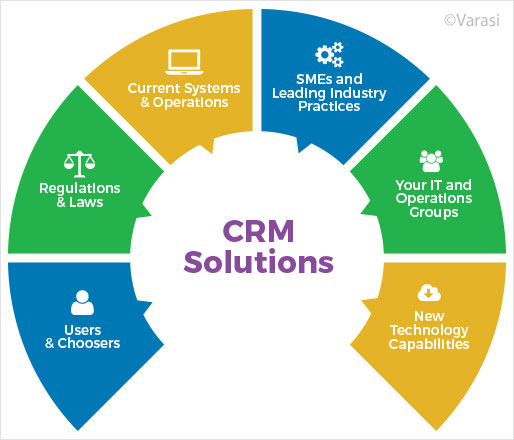- Stronger Customer Relationships
- +1-949-878-7411
- ramana@varasi.com
Beyond Users and Choosers – Sources for Salesforce CRM Requirements

The users and choosers (sponsors) of the system are the obvious sources of requirements. These users and sponsors could be internal or external to your organizations; they could include your customers, partners. You ask them, you observe them, you understand their needs, goals and aspirations and derive the functional requirements of the Salesforce CRM system you are building for them. What sources if any, beyond these users?
Turns out, in the world of CRM, depending on the nature of business function, industry, company, the requirements for the system you are building could come from any one or more of these categories of sources, beyond the users and choosers :

1. Regulations and Laws
There may be parts of the system that have entirely to do with what the regulations stipulate. More so when you are from the more regulated industries such as healthcare, financial services.
Take for example, the compliance requirements from HIPAA (Health Insurance Portability and Accountability Act). While a number of platform features under 'Salesforce Shield' such as Field Audit Trail, Platform Encryption, Data Archiving and Event Monitoring may address the requirements, your organization's use of the system, the third party systems it integrates with, the interfaces used are aspects that should make it into your requirements.
2. Current Systems, Practices & Operations
A not-so-obvious source for requirements is the list of shortcomings of current CRM systems. The limitations and frustrations from the systems in use are sources of requirements in themselves
Every enterprise has developed over the years, rules and policies in running their business. Charts of Authority (COA) for approvals of discounts for sales, categories for calculating pipeline & forecasts, SLAs for support cases are all examples from Salesforce CRM implementations where your organization's unique business practices need to be captured. Questioning the relevance or validity of the business rules is a great source in itself for identifying improvement opportunities and requirements.
Looking through customer complaints and analyzing number of complaints by process area was for instance an exercise we went through on one of our projects to decide on the user needs and priority. We had the Business Analysts for the new system read through customer forums and abstract out requirements.
3. Subject Matter Experts & Leading Industry Practices
You are likely to rely on industry experts for your requirements, more so if you are building a product on the Appexchange. For Salesforce implementations inside organizations, you may be relying on SMEs for industry best practices or those unique to your organization that give you a competitive edge.
Going alongside the Subject Matter experts is industry best practices you see your competitors employ. This is again, even more true for product teams. Benchmarking capabilities in leading products not just in your industry but in unreleated industries is a useful exercise for writing up requirements for your needs.
4. Your IT and Operations
These are the groups within your organization that need to maintain the application over the long haul. Administrative functions, Authentication, External Interfaces, Access to Historical Data, Archiving Requirements are some of the many aspects that the IT and Operations groups are the best stakeholders to capture, for you.
Administrative functions may not be all 'out of the box' features ; they may have to do with changing business practices. A good Salesforce solution will make it easy for the super users to handle many of such functions without having to necessarily rely on a certified Salesforce Administrator.
5. Industry solutions and other new capabilities from Salesforce
Much as we would like to be business process and need led in our requirements gathering, the newer capabilities that a technology provides gives rise to new possibilities. As an example, we are witnessing this with the announcement from Salesforce of Einstein, its AI product line powering its standard CRM offerings. Having the capabilities at your disposal will liberate you to think of opportunities to include them into your requirements.
An interesting related source is the industry solutions from Salesforce or partners. The industry solutions on Appexchange, Financial Services Cloud, Health Cloud and Lightning Bolt solutions from partners are examples in the Salesforce world.
Business processes and needs of several industry participants at large are harnessed into the pre-packaged solution. For the smaller and mid-market customers, such a package in itself offers a jump start to their operations. Also on an ongoing basis, the vendors are getting to see the customizations that their customers are making, the enhancements they are asking for and are turning these into features they build into the future releases of the software. If you are implementing such an industry solution, the package in itself is a good starting point for requirements.



